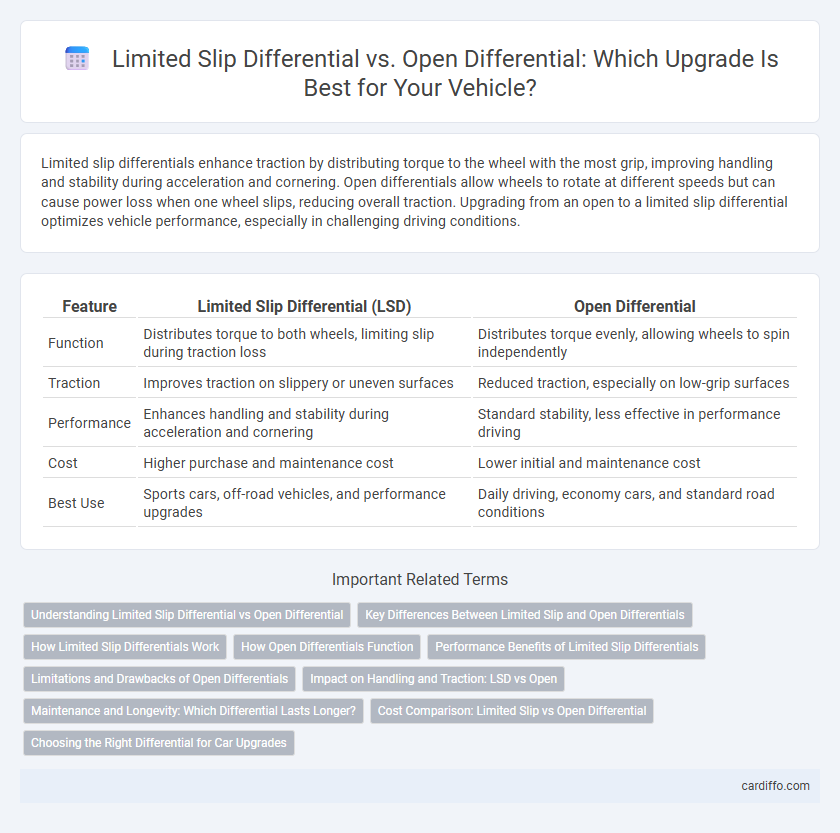Limited slip differentials enhance traction by distributing torque to the wheel with the most grip, improving handling and stability during acceleration and cornering. Open differentials allow wheels to rotate at different speeds but can cause power loss when one wheel slips, reducing overall traction. Upgrading from an open to a limited slip differential optimizes vehicle performance, especially in challenging driving conditions.
Table of Comparison
| Feature | Limited Slip Differential (LSD) | Open Differential |
|---|---|---|
| Function | Distributes torque to both wheels, limiting slip during traction loss | Distributes torque evenly, allowing wheels to spin independently |
| Traction | Improves traction on slippery or uneven surfaces | Reduced traction, especially on low-grip surfaces |
| Performance | Enhances handling and stability during acceleration and cornering | Standard stability, less effective in performance driving |
| Cost | Higher purchase and maintenance cost | Lower initial and maintenance cost |
| Best Use | Sports cars, off-road vehicles, and performance upgrades | Daily driving, economy cars, and standard road conditions |
Understanding Limited Slip Differential vs Open Differential
A Limited Slip Differential (LSD) enhances traction by distributing torque to the wheel with the most grip, preventing wheel spin during acceleration or cornering. In contrast, an Open Differential allows wheels to rotate at different speeds but often directs power to the wheel with less traction, reducing stability on slippery surfaces. Understanding the key differences between LSD and open differentials is crucial for optimizing vehicle performance in varying driving conditions.
Key Differences Between Limited Slip and Open Differentials
Limited Slip Differentials (LSD) enhance traction by distributing torque to the wheel with the most grip, reducing wheel spin during acceleration or cornering, unlike Open Differentials which send equal torque to both wheels regardless of traction. LSDs improve vehicle handling and stability on slippery or uneven surfaces, making them ideal for performance and off-road driving. Open Differentials offer simpler design and lower cost but sacrifice traction control, leading to potential loss of power when one wheel loses grip.
How Limited Slip Differentials Work
Limited Slip Differentials (LSD) improve traction by distributing torque between wheels, allowing power transfer to the wheel with more grip during challenging driving conditions. Unlike Open Differentials, LSDs employ clutch packs, gears, or viscous fluids to limit wheel slip and enhance stability on slippery or uneven surfaces. This mechanism optimizes vehicle control and performance, especially in high-performance and off-road applications.
How Open Differentials Function
Open differentials function by allowing each wheel to rotate at different speeds, which is essential for smooth turning on paved roads. They distribute engine torque evenly to both wheels, but when one wheel loses traction, power is sent primarily to the slipping wheel, reducing overall traction. This limitation makes open differentials less effective in off-road or slippery conditions compared to limited slip differentials.
Performance Benefits of Limited Slip Differentials
Limited Slip Differentials (LSD) enhance vehicle performance by distributing torque more effectively between wheels, improving traction during cornering and slippery conditions. Unlike Open Differentials that send power to the wheel with least resistance, LSD minimizes wheel spin, resulting in better acceleration and stability. This makes LSDs a preferred upgrade for performance vehicles seeking improved handling and control.
Limitations and Drawbacks of Open Differentials
Open differentials often suffer from torque being sent to the wheel with the least traction, leading to wheel spin and decreased vehicle stability on slippery surfaces. They lack the ability to distribute power effectively between wheels during cornering or off-road conditions, resulting in reduced traction and control. This limitation makes open differentials less suitable for performance driving or challenging terrain compared to limited slip differentials.
Impact on Handling and Traction: LSD vs Open
Limited Slip Differentials (LSD) significantly improve handling and traction by distributing torque more effectively to the wheels with the most grip, especially during cornering and uneven surfaces. Open Differentials allow wheels to spin independently, often leading to reduced traction in low-grip conditions as power is sent to the wheel with less resistance. Upgrading to an LSD enhances vehicle stability, cornering performance, and acceleration by minimizing wheel slip and maximizing power delivery.
Maintenance and Longevity: Which Differential Lasts Longer?
Limited slip differentials (LSD) typically require more frequent maintenance than open differentials due to their complex internal components and clutch packs that may wear over time. Open differentials have fewer moving parts, resulting in lower maintenance demands and generally longer operational life under normal driving conditions. Proper lubrication and timely fluid changes are crucial for extending the longevity of both types, but LSDs often face higher wear rates in high-performance or off-road applications.
Cost Comparison: Limited Slip vs Open Differential
Limited slip differentials typically cost between $500 and $1,500, reflecting their advanced traction control and performance benefits, whereas open differentials generally range from $200 to $600, making them a more budget-friendly option. The higher price of limited slip differentials is justified by improved handling and reduced wheel slip, especially in high-performance and off-road vehicles. Maintenance and installation costs for limited slip differentials can also be higher due to their complex design compared to the simpler open differential systems.
Choosing the Right Differential for Car Upgrades
Choosing the right differential for car upgrades depends on your driving needs and performance goals. A limited slip differential (LSD) improves traction by distributing power to the wheel with more grip, making it ideal for sporty driving and off-road conditions, while an open differential allows wheels to rotate at different speeds but can struggle with traction in low-grip situations. Prioritizing LSD enhances cornering stability and acceleration in dynamic environments, whereas open differentials offer simplicity and cost-effectiveness for everyday driving.
Limited Slip Differential vs Open Differential Infographic

 cardiffo.com
cardiffo.com